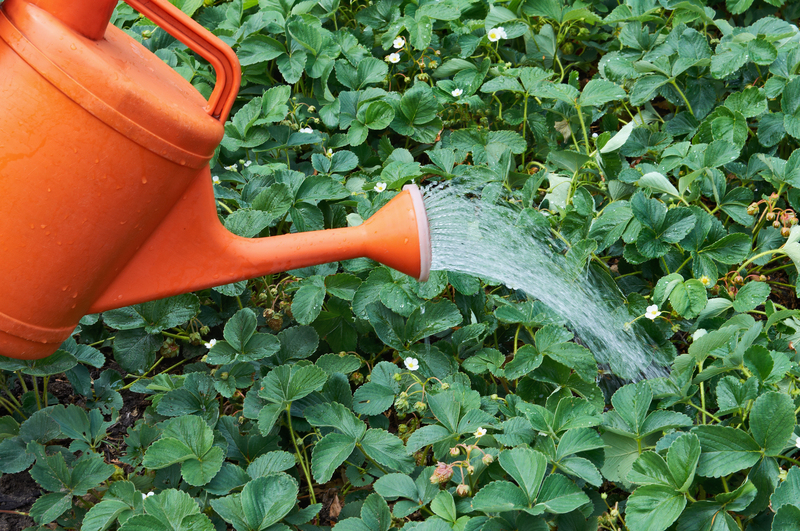Seasoned Gardener's 3 Winning Tips for Weed Deterrence
Posted on 21/09/2025
Seasoned Gardener's 3 Winning Tips for Weed Deterrence
Weeds are a persistent problem that can undermine even the most diligent gardener's efforts. Whether you have a sprawling landscape or a compact urban backyard, weed deterrence is a crucial element of garden care. Experienced gardeners know that the battle against weeds is ongoing, but with the right strategies and knowledge, you can tip the odds in your favor. In this comprehensive guide, we break down the three most effective methods favored by seasoned green thumbs for maintaining a weed-free garden.

Understanding the Weed Challenge: Why Is Weed Deterrence Essential?
Weeds compete with your flowers, shrubs, and vegetables for nutrients, sunlight, and water. They can choke out desirable plants, reduce yields, and introduce pests or diseases. This is why weed prevention is as important as removal. Many gardeners focus on post-emergence control, but seasoned experts employ proactive tactics to keep weeds at bay from the very beginning.
- Weeds rob soil of nutrients, impacting plant growth.
- They serve as habitats for insects and plant diseases.
- Dense weed growth diminishes your garden's beauty and health.
- Certain weeds release chemicals inhibiting other plants (allelopathy).
Tip #1: Master the Art of Mulching
Mulching - The First Line of Defense for Weed Deterrence
If there's one lesson a seasoned gardener will impart, it's this: Mulch is your best friend for weed control. Mulching involves covering the surface of your soil with a protective layer, which offers many benefits--weed reduction being chief among them.
- Suppresses sunlight: Mulch acts as a barrier, preventing sunlight from reaching weed seeds, effectively inhibiting germination.
- Retains moisture & moderates soil temperature: Your plants benefit while weeds struggle to take hold.
- Adds organic matter: As mulch breaks down, it enriches the soil, cultivating healthier plants that are more weed-resistant.
Types of Mulch for Superior Weed Prevention
- Organic mulches: Wood chips, straw, shredded bark, grass clippings, leaves, and compost. These decompose over time and improve soil structure.
- Inorganic mulches: Landscape fabric, gravel, or black plastic sheeting--ideal for paths or long-term beds, though they do not improve soil health.
A seasoned gardener typically layers mulch 2-4 inches deep and ensures there are no gaps where determined weeds might sprout. Mulch should be replenished regularly to maintain its deterrent effect and visual appeal.
Pro Mulching Tips:
- Start early in the season before weeds have a chance to emerge.
- Avoid piling mulch up against stems or plant bases--this can invite rot and pests.
- Use newspaper or cardboard beneath mulch as an added weed barrier.
Remember, in the battle of mulch vs. weeds, consistency is key!
Tip #2: Smart Planting Strategies - Outcompete the Weeds
Dense Planting Equals Fewer Weeds
One of the most overlooked yet highly effective weed prevention methods is planting strategically to minimize open soil. Experienced gardeners know that weeds thrive where there is space and opportunity. By choosing the right plants and arranging them thoughtfully, you outcompete weeds for vital resources.
- Close spacing: Planting groundcovers, vegetables, or ornamentals closely creates shade that blocks weed growth.
- Companion planting: Use vigorous growers next to less robust plants to help keep bare soil--a weed favorite--covered.
- Sow cover crops: For off-season or resting beds, cover crops like clover or rye prevent weeds and improve soil health simultaneously.
Plant Selection for Weed Deterrence
- Dense groundcovers: Creeping thyme, sedum, pachysandra, and sweet woodruff are popular choices that quickly blanket soil.
- Fast-spreading vegetables: Squash, pumpkins, and sweet potatoes shade underlying soil efficiently in vegetable gardens.
- Perennials and shrubs: Clustered plantings in flower beds or borders reduce opportunities for weeds to invade.
Rotating crops and rearranging plantings annually can disrupt weed life cycles. Regularly fill gaps after harvesting or thinning to minimize open ground, and always promptly replace any removed plants with seedlings or mulch.
Expert Planting Tip:
- Use living mulches--low-growing plants interspersed among taller crops to shade and suppress weeds naturally. For example, use white clover under corn or tomatoes.
These smart planting strategies are sustainable and eco-friendly, harnessing nature's own competition to keep weed populations down.
Tip #3: Proactive, Manual, and Organic Weed Control
Stay Ahead: The Early and Often Approach
Even with the best prevention, some weeds will manage to break through. Seasoned gardeners are vigilant, using manual and organic methods to keep their gardens in top shape and weed-free. The real secret here is consistency:
- Regular inspections: Walk your garden weekly to spot and address new weeds before they mature and seed.
- Pull weeds early: Young weeds are easier to uproot, and removing them before they flower averts future infestations.
- Till minimally: Excessive soil disturbance brings new weed seeds to the surface. Use a hoe, hand-puller, or knife for precision removal instead.
Organic Weed Control Methods that Seasoned Gardeners Swear By
- Boiling water: Effective for cracks in pavement or patios--pour carefully to avoid desirable plants.
- Vinegar sprays: Strong, natural vinegar can burn annual weeds. Use with caution on a dry, sunny day.
- Corn gluten meal: Acts as a natural pre-emergent herbicide, preventing seeds from sprouting.
- Flame weeding: Propane torches are used for quick spots in walkways (not for drought-prone areas).
Manual Weeding Tools of the Trade
- Hand weeder/pulling fork: Ideal for dandelions and taproot weeds.
- Serrated or stirrup hoes: Skim just beneath the surface to sever weeds without excessive soil disturbance.
- Kneeling pad: Comfortable manual weeding in flower beds and borders.
The key is to never let weeds go to seed. A single mature weed can produce thousands of seeds, leading to years of recurring problems. Weed after rain for easier root removal, and always dispose of the roots and seed heads--don't compost them unless your pile reaches hot, weed-killing temperatures.
Extra Strategies from Veteran Gardeners for Ongoing Weed Suppression
Stay Organized - Record and Rotate
- Garden journal: Track areas of repeated weed trouble and plan proactive treatments for the next season.
- Crop rotation: Rotating vegetables curbs the spread of weed species that thrive in monocultures.
Embrace Healthy Soil Practices
- Enrich the soil: The healthier the soil, the stronger your plants--and the fewer opportunities weeds will have.
- Maintain optimal pH: Some weeds favor acidic or compacted soils. Amending and aerating soil reduces their chances.
Preventative Edging and Barriers
- Install edging: Prevents encroachment of aggressive grasses or weeds from neighboring lawns.
- Utilize physical barriers: Use cardboard, landscape fabric, or stones under paths, patios, and beds to block persistent perennials.
Common Weed Deterrence Mistakes to Avoid
- Letting weeds seed: The biggest error is procrastination. Remove weeds before they flower or go to seed!
- Mulching over live weeds: Always remove or smother weeds before applying fresh mulch layers.
- Ignoring garden borders: Weeds often invade from the margins--regularly patrol and maintain edges.
- Overwatering: Consistently damp soil encourages weed seed survival; water only when necessary and target plant bases.
Takeaway: Sustainable Weed Prevention for a Lush, Flourishing Garden
No garden is immune to weeds, but with proven weed deterrence strategies, you can create a healthy ecosystem where your plants thrive and weeds struggle to gain a foothold. Remember, experienced gardeners succeed not by eliminating every weed, but by maintaining balance and leveraging reliable methods:
- Mulch generously--block weeds and enrich soil simultaneously.
- Plant densely and smartly--outcompete weeds naturally.
- Act promptly and consistently--monitor, pull, and target weeds with organic solutions.
By integrating these time-tested approaches, you set your landscape up for multi-season weed suppression and a beautiful, low-maintenance garden. Let your garden be a testament to your expertise and love for nature--lush, orderly, and, most importantly, free from unwelcome weeds!

Frequently Asked Questions on Weed Deterrence
How often should I apply mulch for effective weed prevention?
Reapply organic mulch every 1-2 years, or as it decomposes and thins out. Inorganic mulches can last longer but may require occasional top-ups or cleaning.
Can I ever be completely weed-free?
While it's unlikely any garden will be 100% weed-free, persistent use of the above weed deterrence methods can drastically reduce weed problems so your garden remains easy to maintain and visually stunning.
Is it necessary to weed in winter?
Yes. Remove emerging weeds as they appear even in cooler months, as some species are hardy and will set seed before spring arrives.
Are chemical herbicides recommended by expert gardeners?
Most seasoned gardeners prefer manual and organic methods for weed deterrence to protect soil health and pollinators. Chemical solutions are usually a last resort for severe infestations or invasive species management.
In Summary: Master the Craft of Weed Deterrence
With these three winning tips for weed deterrence--mulch mastery, strategic planting, and persistent organic control--you'll be following in the footsteps of gardening veterans worldwide. Your dream of a beautiful, weed-resistant garden is within reach! Implement these time-honored practices, customize them to your unique space, and enjoy a thriving landscape season after season.



